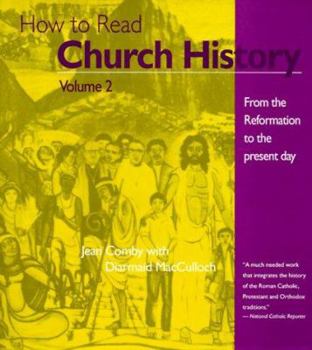How to Read Church History: From the Reformation to the Present Day
Select Format
Select Condition 
Book Overview
Like the first volume, this fascinating history sets the development of Christianity from the sixteenth century to the present in the wider history of the world. This description may be from another edition of this product.
Format:Paperback
Language:English
ISBN:0824509080
ISBN13:9780824509088
Release Date:October 1989
Publisher:Crossroad Publishing
Length:246 Pages
Weight:1.25 lbs.
Dimensions:0.7" x 7.8" x 9.2"
Customer Reviews
2 ratings
Staying current...
Published by Thriftbooks.com User , 21 years ago
Jean Comby collaborated with Diarmaid MacCulloch for the text, 'How to Read Church History: Volume 2', which covers the period from the beginnings of the Reformation in the fifteenth century to the near present time (Vatican II and the immediate aftermath). It is part of a series by the Crossroad Press on how to read or study different aspects of church history, practice, and belief. Divided into thirteen chapters, it examines the Reformation in its various incarnations, the Counter-Reformation, the influence of colonial expansion on the church, the rise of Enlightenment ideas into the church, the globalisation of the church, and the modern period. This text was originally published in French, translated a few years later for the benefit of English-reading audiences. For a book that was prepared before the wide-spread influence of the internet, it bears a remarkable similarity to modern web pages in its format and design. There are boxes, highlighted areas, pull-quotes, sidebars and other features throughout -- this is no simple, boring narrative. There are charts (chronologies, canons, etc.), maps, timelines, definitions, line-art drawings, and more. Church history is a history of people in the world. Thus, a good deal of space is devoted to explaining the world in which Christianity existed. Chapters do have recommended reading lists on each topic, and at the beginning of this volume there is a recommended list of expanded histories. Each of the thirteen chapters is brief, supplemented with maps, charts, boxes, and more. The narrative history could be read in but a few sittings (perhaps, for the quick reader, even in one sitting). This can then be fleshed out by including the complementary information upon second reading. Like much of history, some memorisation of dates, persons, places, movements, etc. would be helpful -- the style of this text makes that much more easy to do. There is a great deal of diversity within the history of the church, with lots of strands that can easily become confusing, particularly as the church in the West split into ever more denominations, and those denominations gave rise to regional and doctrinal variations even within themselves. The format of this book lays out the different lines in an organised way, showing the divergences and the inter-relationships well.This is a book of context and background. It does not take the place of doing reading in the primary texts. One will never get the true sense from the great Reformers, for example, by reading the summary here. However, one will get a greater appreciation for the larger Christian and social context into which they were born and from which they were writing. To this end, Comby and MacCulloch give suggestions on how to read these types of texts, reminding the reader here that the worldview was quite different, and the presumed message from the the text will be different today than in the past. Also recommended are more modern surveys o
Study Resource
Published by Thriftbooks.com User , 21 years ago
Jean Comby's volume, "How to Read Church History: From the Reformation to the Present Day," is the second in a two-volume work, which in turn is part of a series of "how to read" books. I've used this book as a text book in a course I teach in Christian History, and I chose it for Comby's approach to source material. Personally, the first time I picked up the book I found it very readable, but wondered how my students would feel about it. When I elicited feedback, I discovered is that those who have a background in Western Civilization and European history do enjoy the book (Comby, after all, is a Frenchman and writes from a European perspective). My Asian students have a harder time with the text -- not for what is written, but for what is not written. In other words, without a background in European and Western history and thought, the work appears more difficult. Comby often speaks in passing of certain Western personages, trends and movements, taking for granted that his readers are familiar with these from other sources. Having said that, and for those who do have background in Western Christianity and civilization, the volume presents a balanced view of Church history through the developments of the last five centuries. The author writes so as to invite dialogue; his tone is upbeat. Last week, while in the campus bookstore, I overheard one of my former students recommend the book to a friend of hers. This erased any doubts I had about putting the book on my list for the next time I teach modern and contemporary Church history.





